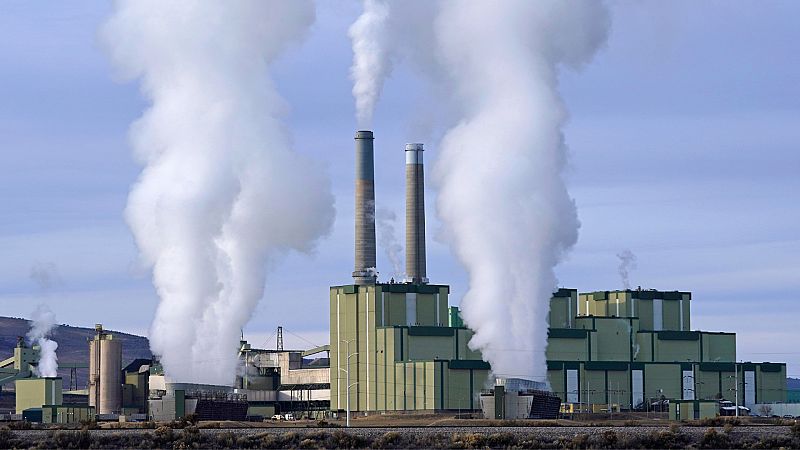‘We clearly are not doing enough’: Global carbon emissions head for record high in 2024

This year humanity is pumping 300 million metric tonnes more carbon dioxide into the air by burning fossil fuels than it did last year.
This year the world is on track to put 37.4 billion metric tonnes of the main heat-trapping gas into the atmosphere. It’s a 0.8 per cent increase from 2023, according to Global Carbon Project, a group of scientists who track emissions.
Several United Nations reports say the globe must cut emissions by 42 per cent by 2030 to to be in with a chance of limiting warming to the internationally agreed-upon threshold of 1.5C.
This year's pollution increase isn't quite as large as last year's 1.4 per cent jump, scientists said while presenting the data at the United Nations climate talks in Azerbaijan.
Despite the urgent need to cut emissions to slow climate change, the researchers say there is still “no sign” that the world has reached a peak in fossil fuel CO2 emissions.
We have six years before passing 1.5C
If the world continues burning fossil fuels at today's level, it has six years before passing 1.5 degrees Celsius above pre-industrial levels - the limit agreed to at the 2015 climate talks in Paris - said study co-author Stephen Sitch.
The Earth is already at 1.3 degrees Celsius, according to the United Nations.
“We clearly are not doing enough on a global scale to reduce emissions. It’s as simple as that,” said study co-author Mike O'Sullivan, a University of Exeter climate scientist.
"We need to massively increase ambition and actually just think outside the box of how we can change things, not be so tied to fossil fuel interests.''
Scientists used reported emissions from rich countries and oil industry data, O’Sullivan said. The 2024 figure includes projections for the last couple months or so.
Where have carbon emissions continued to rise?
The Global Carbon Project team released figures for the four biggest carbon emitters - China, the United States, India and Europe. It also produced more detailed and final figures for about 200 countries for 2023.
The continued rise in carbon emissions is mostly from the developing world and China.
Many analysts had been hoping that China - by far the world's biggest annual carbon polluting nation with 32 per cent of the emissions - would have peaked its carbon dioxide emissions by now.
Instead China's emissions rose 0.2 per cent from 2023, with coal pollution up 0.3 per cent, Global Carbon Project calculated. But it could drop to zero in the next two months and is “basically flat,” O'Sullivan said.
That's nothing close to the increase in India, which at 8 per cent of the globe's carbon pollution is third-largest carbon emitter. India's carbon pollution jumped 4.6 per cent in 2024, the scientists said.
Where did carbon emissions fall?
Carbon emissions dropped in both the United States and the European Union.
They fell 0.6 per cent in the US mostly from reduced coal, oil and cement use. The US was responsible for 13 per cent of the globe's carbon dioxide in 2024.
Historically, it's responsible for 21 per cent of the world's emissions since 1950, a figure that matters since the gas persists in the atmosphere for centuries.
Twenty-two nations have shown steady decreases in emissions, O'Sullivan said, singling out the United States as one of those. The biggest emission drops from 2014 to 2023 were in the United States, Japan, Germany, the United Kingdom and Ukraine.
Europe, which accounts for 7 per cent of the world's carbon pollution, saw its carbon dioxide output drop 3.8 per cent from last year - driven by a big cut in coal emissions.
Carbon emissions are double what they were 50 years ago
Global carbon emissions are well more than double what they were 50 years ago and 50 per cent than they were in 1999. Emissions have gone up about 6 per cent in the past decade.
“This is a needed reminder of the urgency with which we need to address the cause of the climate crisis," said PowerShift Africa founder Mohamed Adow, who wasn't part of the study.
“The problem is the fossil fuel industry is kicking and screaming for us to slow down and to keep them in business for longer. That’s why they poured money into Donald Trump’s election campaign.”
Carbon dioxide from humanity's burning of coal, oil and natural gas amounts to nearly 1.2 million kilograms of the heat-trapping gas every second.
Total carbon emissions which include fossil fuel pollution and land use changes such as deforestation are basically flat because land emissions are declining, the scientists said.
That’s an important and encouraging milestone amid bad news, said University of Pennsylvania climate scientist Michael Mann.

